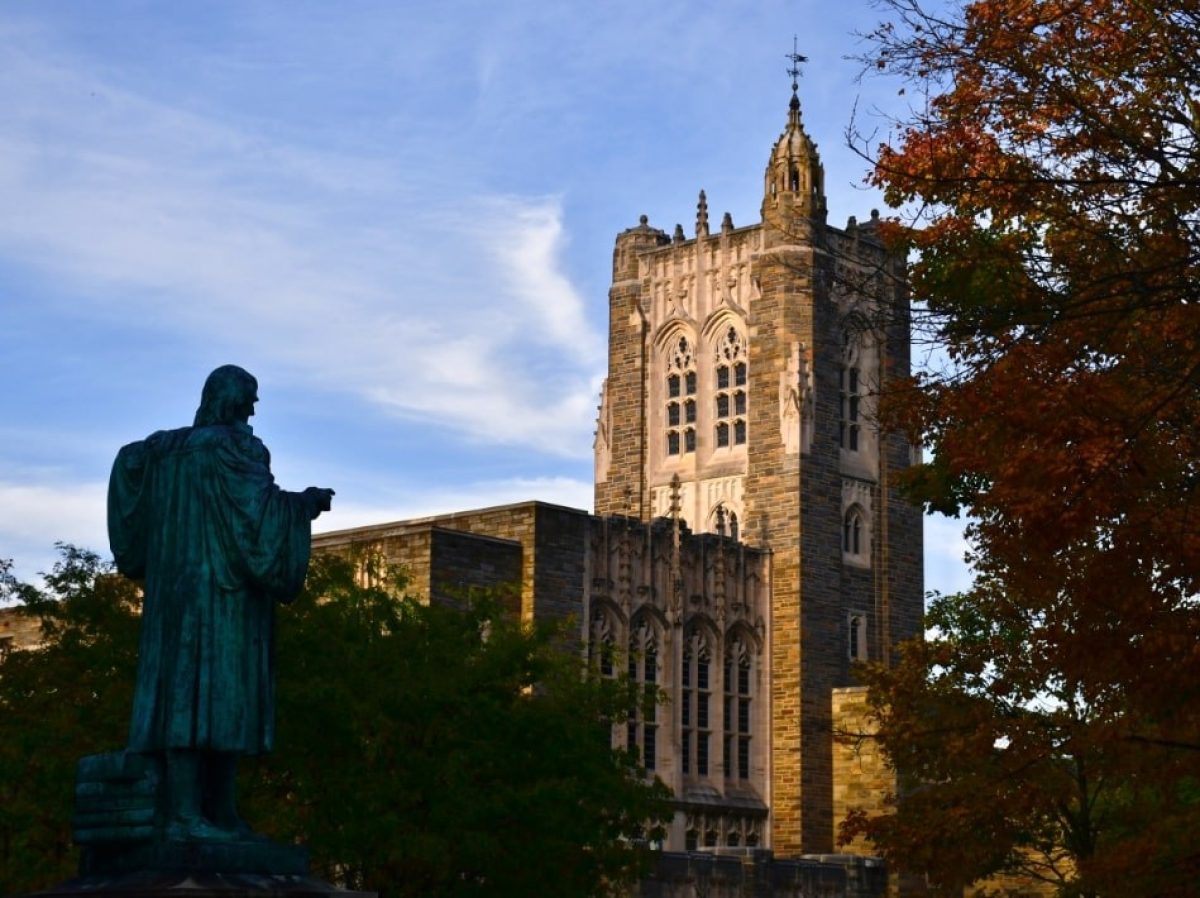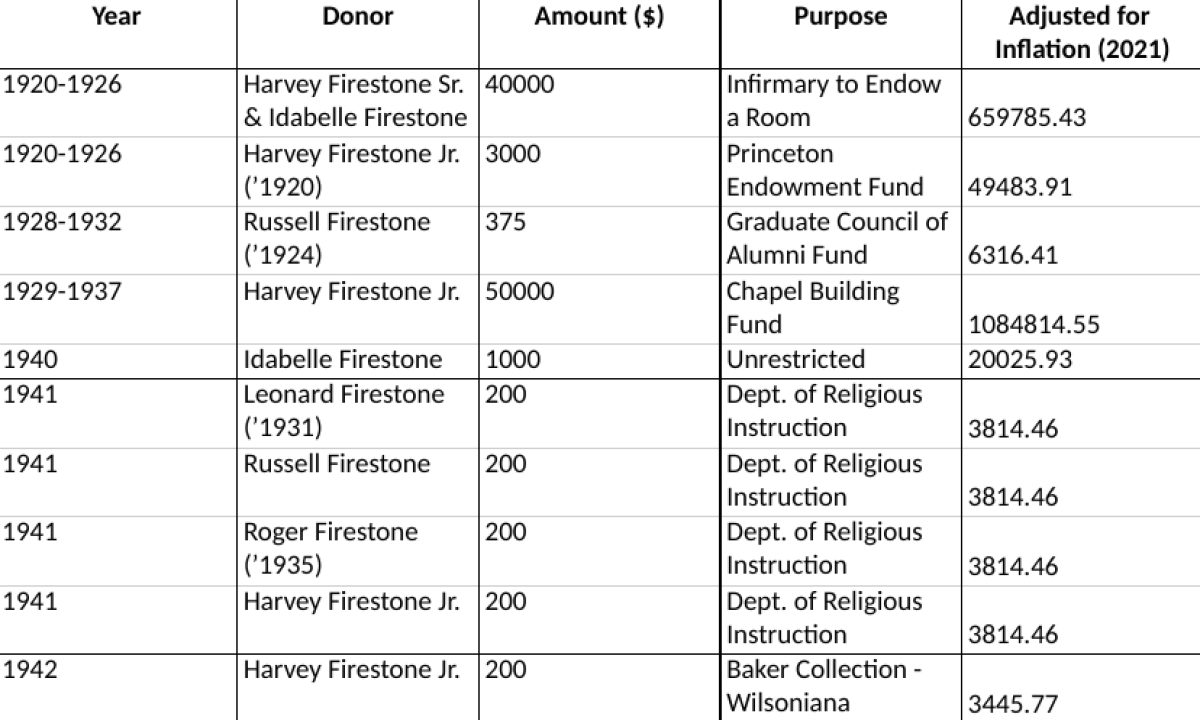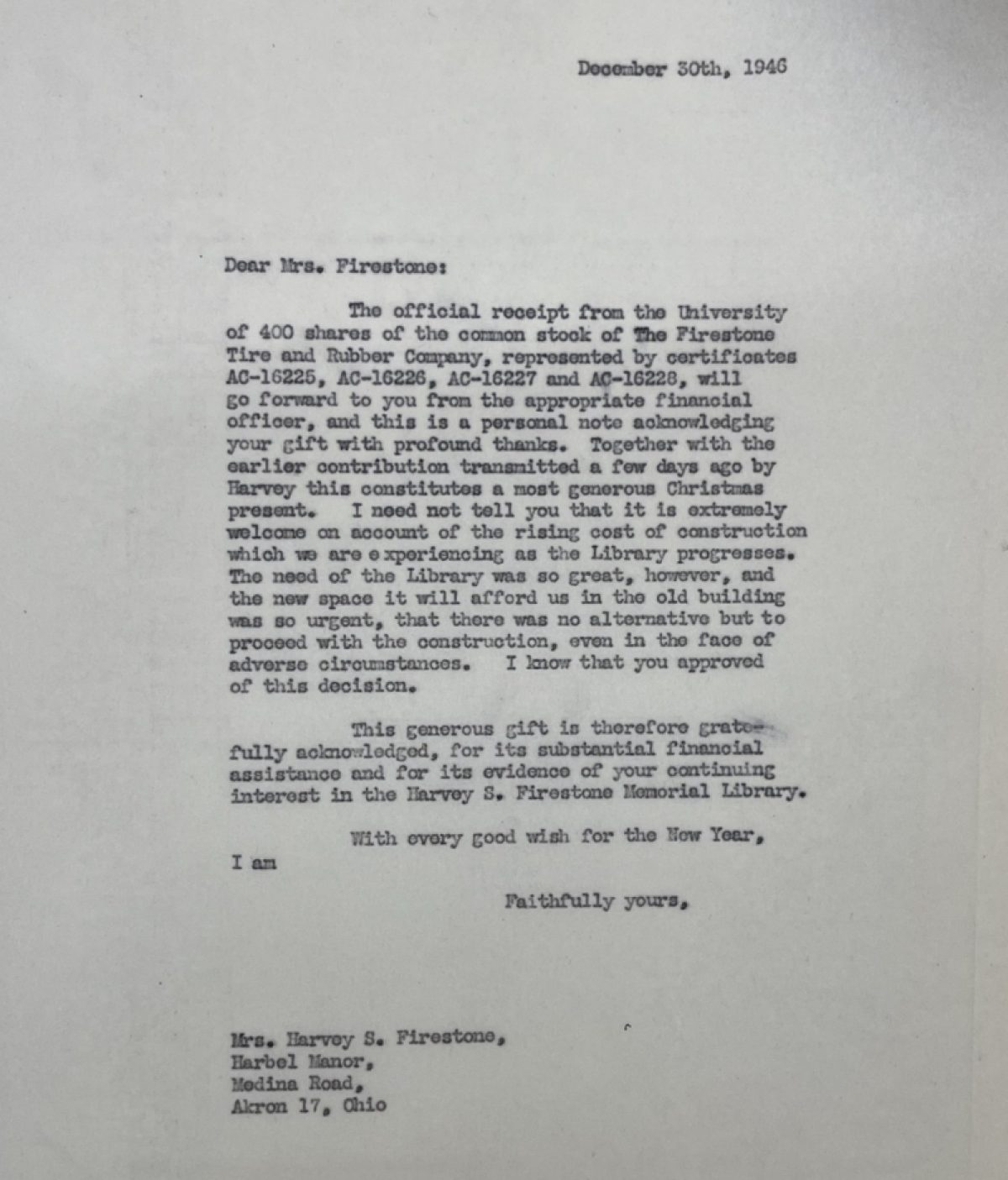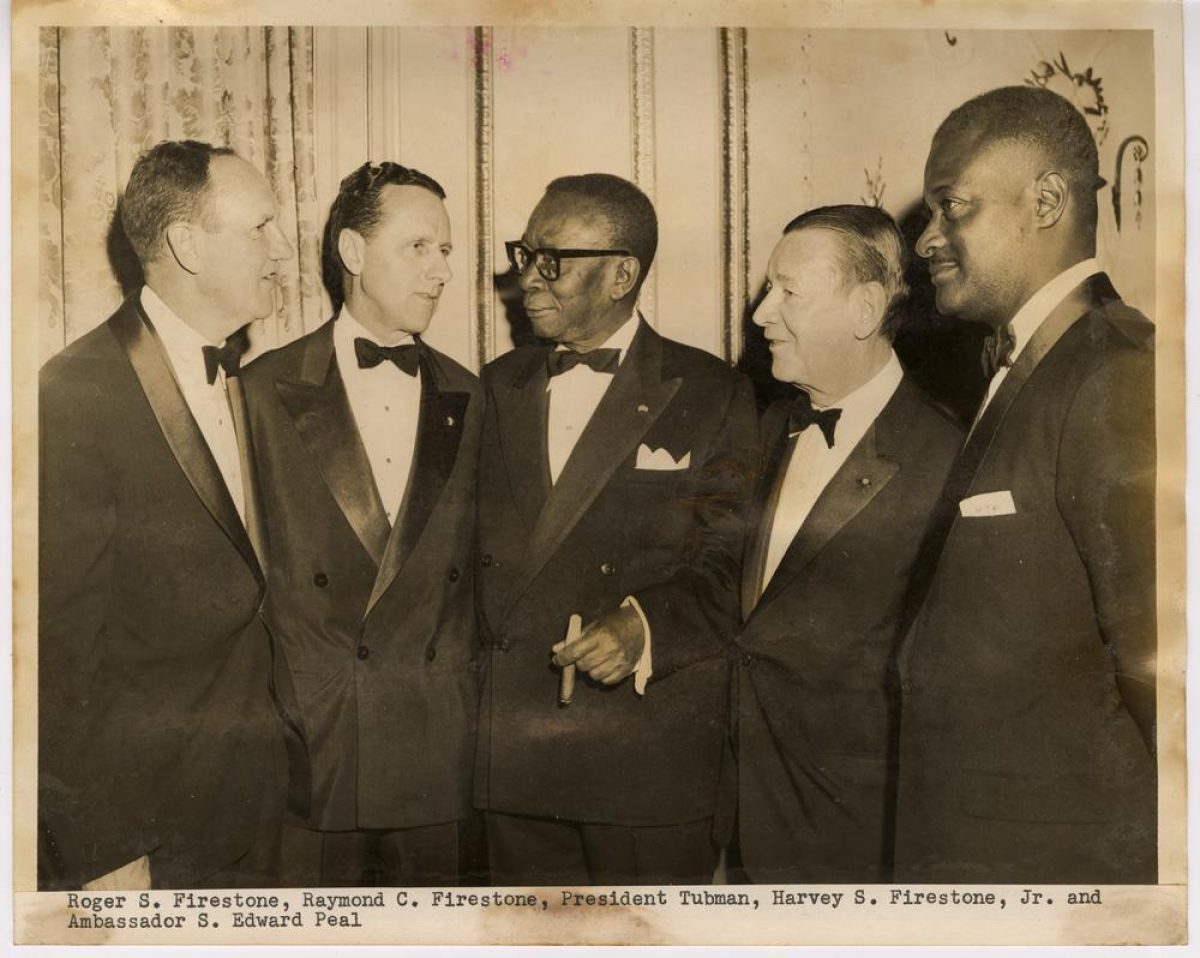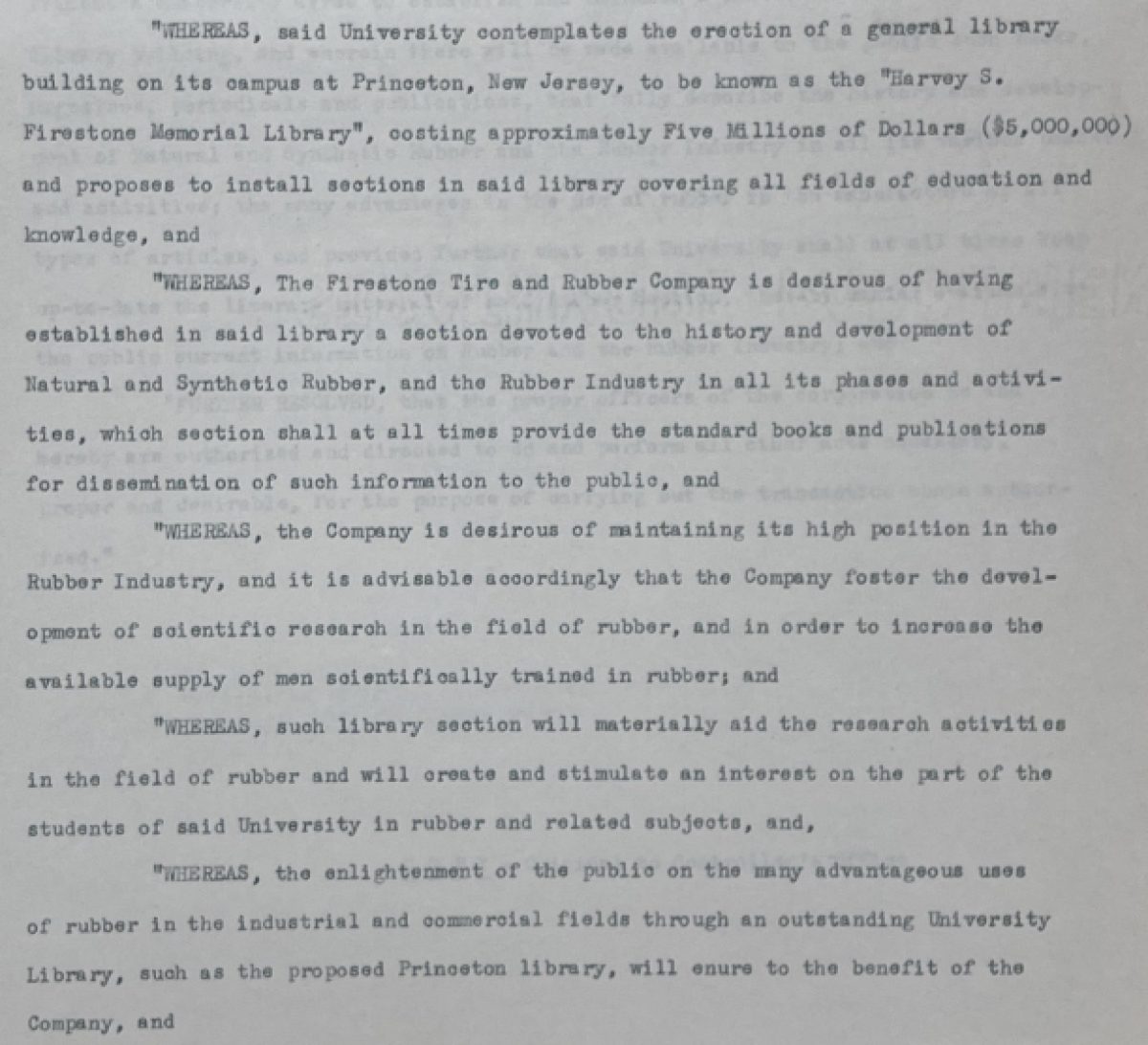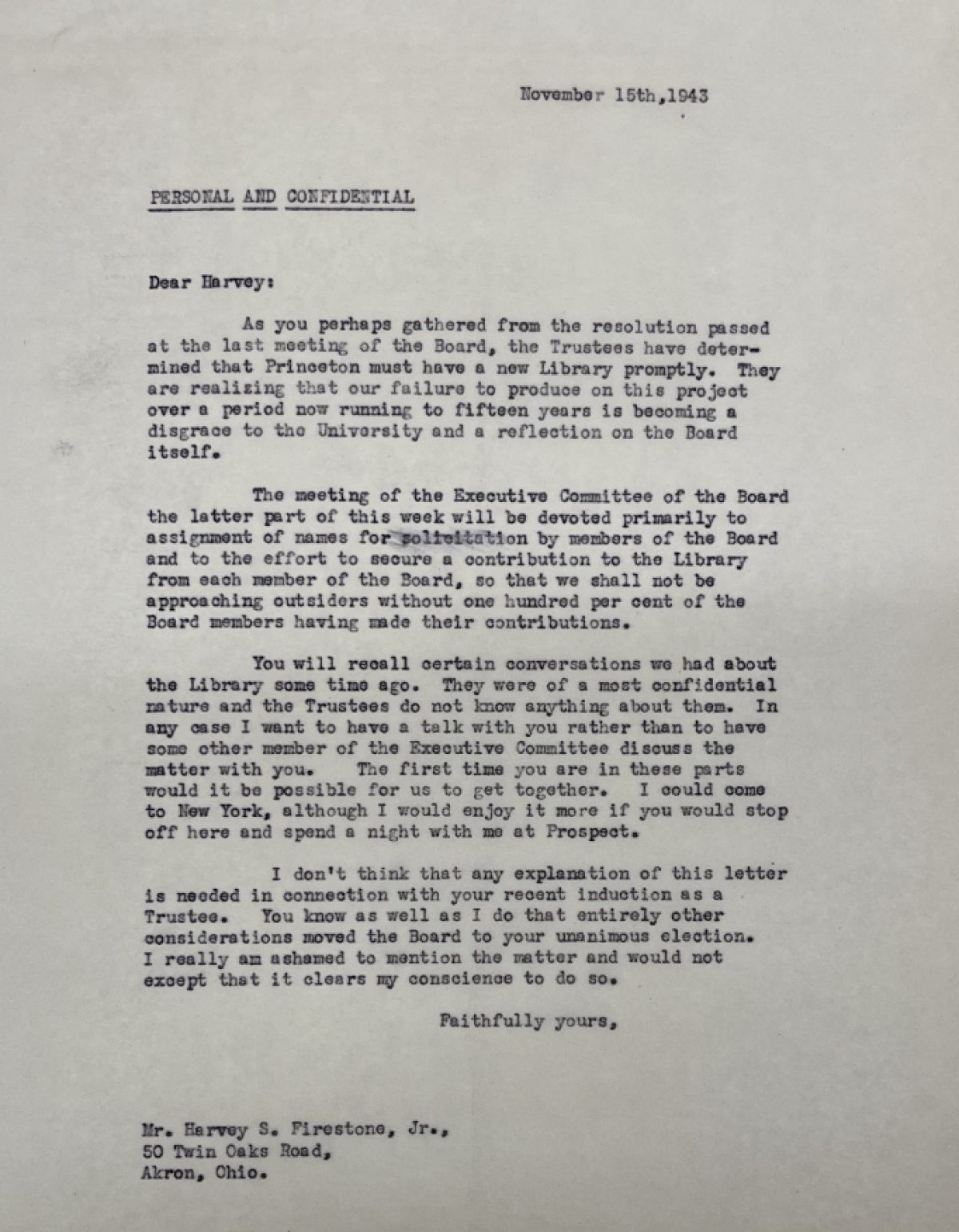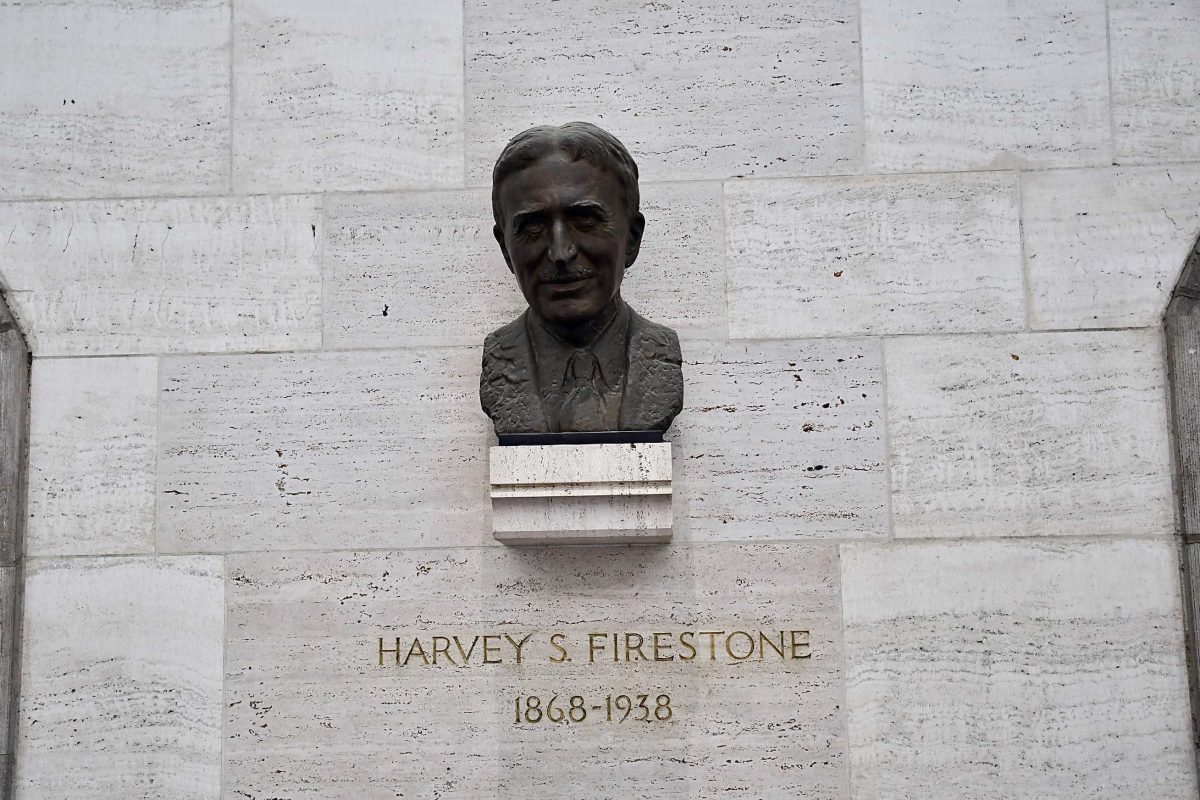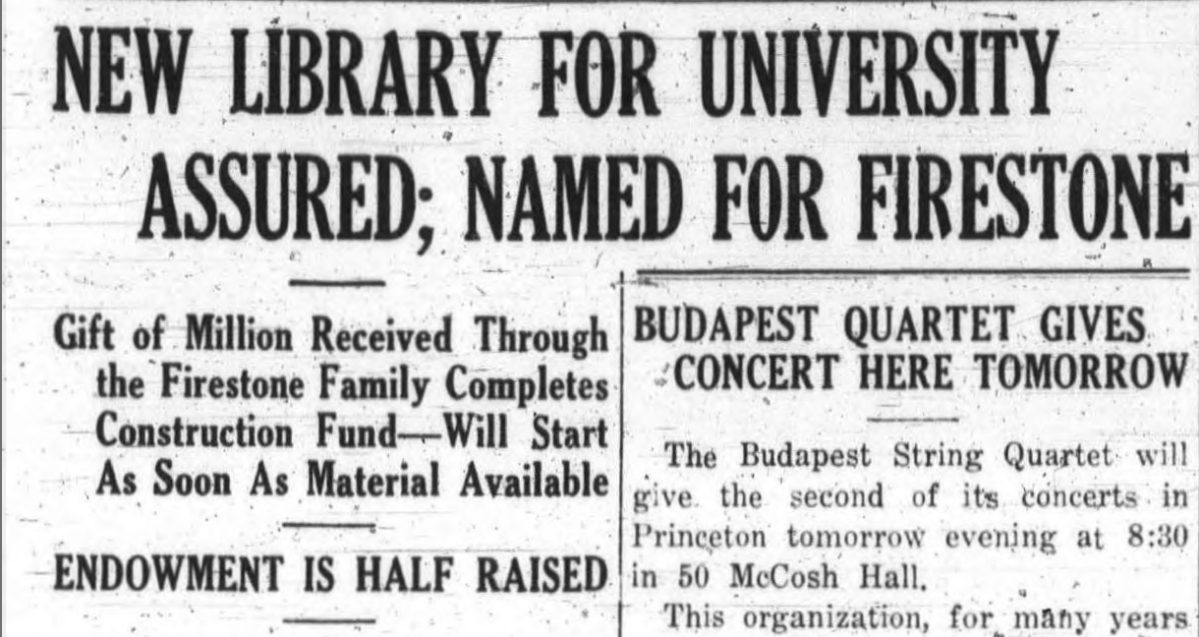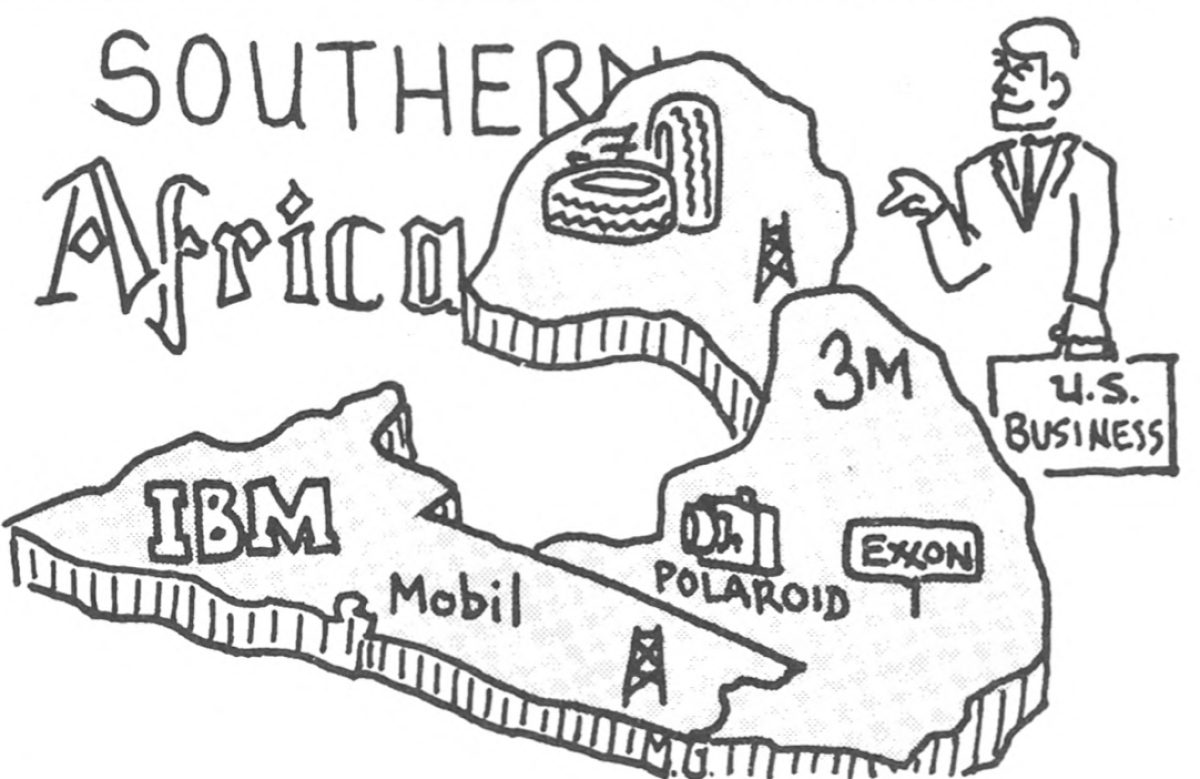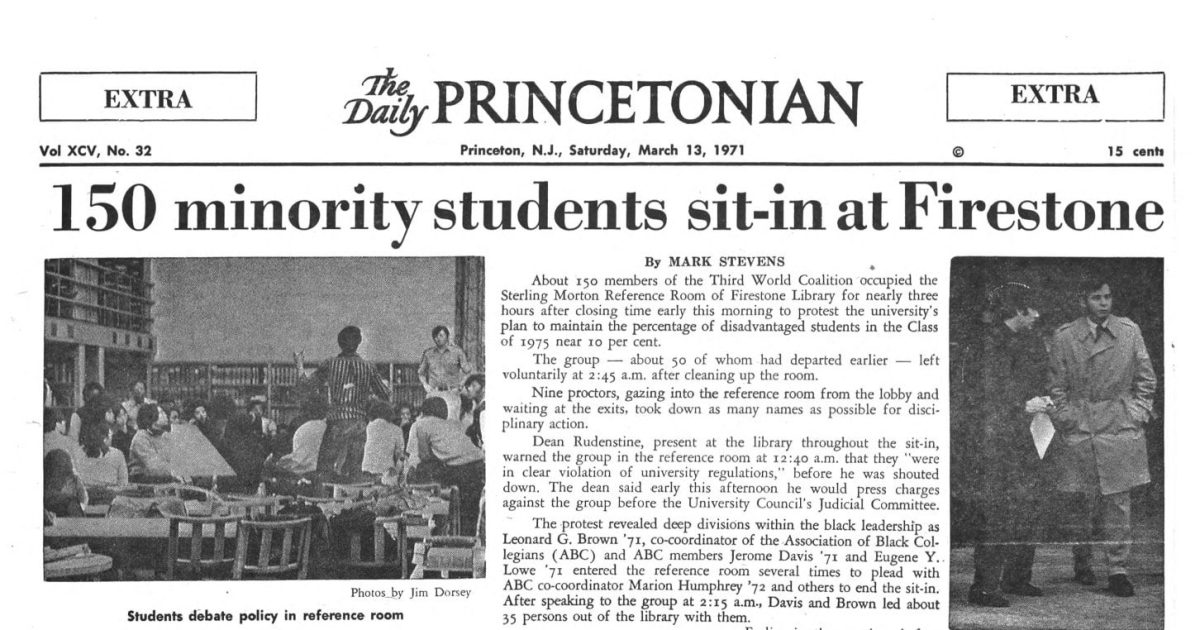[1]
William G. Bowen to John C. Stone II, February 4, 1981; Firestone Gathering, 1981; Office of the President Records: William G. Bowen Subgroup, 1940-1998 (mostly 1972-1987), Box 253, Folder 8; Princeton University Archives, Department of Rare Books and Special Collections, Princeton University Library.
⤴
[2]
Peter Firestone had held corporate positions in the family business from 1964-1970. “Peter S. Firestone ’62,” Princeton Alumni Weekly, January 25, 1982; William G. Bowen to John C. Stone II, February 4, 1981.
⤴
[3]
William G. Bowen to John C. Stone II, February 4, 1981.
⤴
[4]
William G. Bowen to John C. Stone II, February 4, 1981.
⤴
[5]
William G. Bowen to Nicki and Leonard Firestone, February 3, 1981; Office of the President Records: William G. Bowen Subgroup, 1940-1998 (mostly 1972-1987), Box 253, Folder 8; Princeton University Archives, Department of Rare Books and Special Collections, Princeton University Library.
⤴
[6]
“Firestone gift provides Rockefeller College with a social area,” Princeton Weekly Bulletin, February 8, 1982, Papers of Princeton Database, Princeton University Libraries.
⤴
[7]
William G. Bowen to John C. Stone II, February 4, 1981.
⤴
[8]
Gregg Mitman, Empire of Rubber: Firestone’s Scramble for Land and Power in Liberia (New York: The New Press, 2021), xii.
⤴
[9]
“Construction Fund for New Library Assured; Building to Bear Name of Harvey S. Firestone,” The Princeton Bulletin, February 21, 1945, Papers of Princeton Database, Princeton University Libraries.
⤴
[10]
All five of Idabelle and Harvey Firestone Sr.’s sons graduated from Princeton: Harvey S. Firestone Jr. (’1920), Russell A. Firestone (’1924), Leonard K. Firestone (’1931), Raymond C. Firestone (’1933), and Roger S. Firestone (’1935). Other members of the family who attended the University include David Morgan Firestone (’1953), A. Brooks Firestone (’1958), Peter S. Firestone (’1962), John D. Firestone (’1966), William C. Ford (’1979), and Elizabeth Ford (’1983). Firestone relatives by marriage raise the count of Princeton alumni by at least three. To calculate the number of times that they donated to Princeton, I cross-checked two records within the University’s archives: a chart from May 20, 1970, which gives the donations made by Firestone family members and subsidiaries between 1943 and 1969, and a registry from January 2, 1968, which records Firestone gifts between 1920 and 1967. I also considered donations encountered elsewhere in the record, such as the 1982 gift mentioned above. “University Confidential: Research Information,” January 1981; Firestone Gathering, 1981; Office of the President Records: William G. Bowen Subgroup, 1940-1998 (mostly 1972-1987), Box 253, Folder 8; Princeton University Archives, Department of Rare Books and Special Collections, Princeton University Library; “Gifts to Princeton University,” January 2, 1968; Firestone Foundation, 1943-1972; Office of the President Records: Robert F. Goheen Subgroup, 1924-1988 (mostly 1957-1972), Box 215, Folder 9; Princeton University Archives, Department of Rare Books and Special Collections, Princeton University Library; Mitman, Empire of Rubber, 16.
⤴
[11]
Among hundreds of other Firestone donations, the Firestone family gave $1 million to build Firestone Library in 1944; the Firestone Foundation, $60,000 for Jadwin Gym between 1965 and 1967; Harvey Firestone Jr., $50,000 for the Chapel Building Fund between 1929 and 1937; and the Firestone Company, $2,295.25 for chemistry research in 1943. “Gifts to Princeton University,” January 2, 1968; Firestone Foundation, 1943-1972, Box 215, Folder 9; Office of the President Records: Robert F. Goheen Subgroup, 1924-1988 (mostly 1957-1972); Princeton University Archives, Department of Rare Books and Special Collections, Princeton University Library; “A Proposal for Expanding the Harvey S. Firestone Memorial Library,” 1968; Firestone, Harvey S., Jr, 1942-1973; Office of the President Records: Robert F. Goheen Subgroup, 1924-1988 (mostly 1957-1972), Box 485, Folder 8; Princeton University Archives, Department of Rare Books and Special Collections, Princeton University Library.
⤴
[12]
I reached these figures by consulting the aforementioned records (see footnote 10), both of which are accurate but neither of which provides the full picture. Whereas the 1970 chart gives an annual dollar amount for each family member and corporate entity, the 1968 registry tracks family and corporate gifts, often restricted to a particular program or project, across ranges of years. In the absence of further documentation, I could not determine the annual distribution of such gifts. Furthermore, the 1968 registry spans a longer period and includes Firestone family members who do not appear in the 1970 chart. Although a side-by-side comparison of both records allowed me to identify many common gifts, I could not resolve every discrepancy. To avoid double-counting, I took the 1970 chart as authoritative, and I added from the 1968 registry only those gifts whose date or donor are not covered by the chart.
⤴
[13]
I calculated this sum by entering each gift and the year in which it was given into an inflation calculator, which adjusted the amounts for 2021 (the most recent year for which data is available). I then totaled the inflation-adjusted amounts. The inflation calculator that I used may be found here: https://westegg.com/inflation/.
⤴
[14]
Robert F. Goheen to Harvey S. Firestone Jr., December 22, 1967; Firestone Foundation, 1943-1972; Office of the President Records: Robert F. Goheen Subgroup, 1924-1988 (mostly 1957-1972), Box 215, Folder 9; Princeton University Archives, Department of Rare Books and Special Collections, Princeton University Library.
⤴
[15]
M. A. Farber, “11 College Presidents Caution Money Crisis Imperils Future,” The New York Times, July 13, 1970.
⤴
[16]
The University had never run a deficit until 1969. Farber, “11 College Presidents Caution Money Crisis Imperils Future”; Dave Franks, “University trustees try to use capital gains from endowment,” February 2, 1970, The Daily Princetonian, Papers of Princeton Database, Princeton University Libraries.
⤴
[17]
W. E. B. Du Bois, “Liberia, the League and the United States,” Foreign Affairs, Vol. 11, No. 4 (Jul. 1933), 695.
⤴
[18]
Du Bois, “Liberia, the League and the United States,” 695.
⤴
[19]
Du Bois, “Liberia, the League and the United States,” 695.
⤴
[20]
Ibrahim Sundiata, Brothers and Strangers: Black Zion, Black Slavery, 1914-1940 (Durham, NC: Duke University Press, 2003), 114-116; Christine Whyte, “A State of Underdevelopment: Sovereignty, Nation-Building and Labor in Liberia 1898-1961,” International Labor and Working Class History, No. 92 (Fall 2017): 32-33; T. Christian Miller and Jonathan Jones, “Firestone and the Warlord: The Untold Story of Firestone, Charles Taylor, and the Tragedy of Liberia,” ProPublica, November 16, 2014, https://www.propublica.org/article/firestone-and-the-warlord-print.
⤴
[21]
Sundiata, Brothers and Strangers, 114; Mitman, Empire of Rubber, Chapters 1-3.
⤴
[24]
Mitman, Empire of Rubber, 34.
⤴
[25]
Hollander, “Princeton and the Colonization Movement”; Mitman, Empire of Rubber, 33-35.
⤴
[26]
Sundiata, Brothers and Strangers, 167, 222; Mitman, Empire of Rubber, 82, 151, 152.
⤴
[27]
Sundiata, Brothers and Strangers, 223; Mitman, Empire of Rubber, 81-82.
⤴
[28]
Harvey S. Firestone Sr. and Samuel Crowther, Men and Rubber: The Story of Business (New York: Doubleday, Page & Company, 1926), 264.
⤴
[29]
Alfred Lief, Harvey Firestone: Free Man of Enterprise (New York: McGraw-Hill Book Company, Inc., 1951), 260.
⤴
[30]
Sundiata, Brothers and Strangers, 226.
⤴
[31]
Sundiata, Brothers and Strangers, 225.
⤴
[32]
Mitman, Empire of Rubber, Chapter 6.
⤴
[33]
Raymond Leslie Buell, The Native Problem in Africa, Vol. II (New York: The MacMillan Company, 1928), 832, 845.
⤴
[34]
That Buell condemned Firestone’s abuses should not be taken to assure him of righteousness or vindicate him of racism. Racist and paternalistic assumptions pervade his work. For example, Buell claimed that most African communities lacked the maturity to govern themselves, in contradistinction to the white influence that distinguished Liberia. “[T]he Liberian,” he wrote, “does have an intelligence and savoir faire which is unique throughout the continent of Africa. The very fact that the inhabitants of Liberia have been called upon to carry the full burden of government has developed in them qualities which have not yet appeared among natives elsewhere.” Buell, The Native Problem in Africa, 729, 835.
⤴
[35]
Mitman, Empire of Rubber, 81-91.
⤴
[36]
Whyte, “A State of Underdevelopment,” 33.
⤴
[37]
Whyte, “A State of Underdevelopment,” 33.
⤴
[38]
Arthur J. Knoll, “Firestone’s Labor Policy, 1924-1939,” Liberian Studies Journal, Vol. XVI, No. 2 (1991): 54-55.
⤴
[39]
Sundiata, Brothers and Strangers, 226; Mitman, Empire of Rubber, 66-67.
⤴
[40]
Sundiata, Brothers and Strangers, 122-123; Mitman, Empire of Rubber, 56-57.
⤴
[41]
Sundiata, Brothers and Strangers, 122.
⤴
[42]
Sundiata, Brothers and Strangers, 120-121.
⤴
[43]
Sundiata, Brothers and Strangers, 1-3; Mitman, Empire of Rubber, 120-131; Adom Getachew, Worldmaking After Empire: The Rise and Fall of Self-Determination (Princeton, NJ: Princeton University Press, 2019), 58-59.
⤴
[44]
Mitman, Empire of Rubber, 127.
⤴
[45]
League of Nations report quoted in Mitman, Empire of Rubber, 120-131. See also Getachew, Worldmaking After Empire, 61.
⤴
[46]
Getachew, Worldmaking After Empire, Chapter 2; Mark Mazower, No Enchanted Palace: The End of Empire and the Ideological Origins of the United Nations (Princeton: Princeton University Press, 2009), Chapter 1.
⤴
[47]
Getachew, Worldmaking After Empire, Chapter 2.
⤴
[48]
Mitman, Empire of Rubber, 193-194; Miller and Jones, “Firestone and the Warlord.”
⤴
[49]
Mitman, Empire of Rubber, 191.
⤴
[50]
Mitman, Empire of Rubber, 18-19.
⤴
[51]
In 1926, the year he exported his racism to Liberia, Harvey Sr. wrote, “We have found the Negro particularly adapted to handling our raw materials.” Quoted in Mitman, Empire of Rubber, 19.
⤴
[52]
Mitman, Empire of Rubber, 184, 234, passim.
⤴
[53]
Mitman, Empire of Rubber, 179.
⤴
[54]
Sundiata, Brothers and Strangers, 202, 225-228.
⤴
[55]
Mitman, Empire of Rubber, 234.
⤴
[56]
Mitman, Empire of Rubber, 234.
⤴
[57]
Mitman, Empire of Rubber, 202-205.
⤴
[58]
Mitman, Empire of Rubber, 202-204.
⤴
[59]
Mitman, Empire of Rubber, 202-204.
⤴
[60]
Mitman, Empire of Rubber, 205.
⤴
[61]
Mitman, Empire of Rubber, 205; R.S. Bray, “The Susceptibility of Liberians to the Madagascar Strain of Plasmodium vivax,” The Journal of Parasitology, Vol. 44, No. 4 (Aug. 1958): 371-373.
⤴
[62]
Mitman, Empire of Rubber, 176.
⤴
[63]
Mitman, Empire of Rubber, 236, 237.
⤴
[64]
Mitman, Empire of Rubber, 236, 237.
⤴
[65]
Mitman, Empire of Rubber, 237.
⤴
[66]
Miller and Jones, “Firestone and the Warlord,” ProPublica; Mitman, Empire of Rubber, 242.
⤴
[67]
Miller and Jones, “Firestone and the Warlord.”
⤴
[69]
Robert F. Goheen to Harvey S. Firestone Jr., October 31, 1969; Firestone, Harvey S., Jr., 1942-1973; Office of the President Records: Robert F. Goheen Subgroup, 1924-1988 (mostly 1957-1972), Box 485, Folder 8; Princeton University Archives, Department of Rare Books and Special Collections, Princeton University Library.
⤴
[70]
Proposal for The Firestone Visiting Professorship in African Studies, March 23, 1970; Firestone Tire and Rubber Company, 1968-1972; Office of the President Records: Robert F. Goheen Subgroup, 1924-1988 (mostly 1957-1972), Box 215, Folder 10; Princeton University Archives, Department of Rare Books and Special Collections, Princeton University Library.
⤴
[71]
Correspondence between Firestone personnel and Princeton personnel, December 30, 1946; Firestone Jr., Harvey S, 1937-1948; Office of the President Records: Jonathan Dickinson to Harold W. Dodds Subgroup, 1746-1999 (mostly 1830-1869), Box 109, Folder 4; correspondence between Firestone personnel and Princeton personnel, December 23, 1946, December 22, 1947, December 23, 1948, December 30, 1949, December 28, 1950, December 26, 1951, and December 22, 1953; Firestone Foundation, 1943-1972; Office of the President Records: Robert F. Goheen Subgroup, 1924-1988 (mostly 1957-1972); Box 215, Folder 9; correspondence between Firestone personnel and Princeton personnel, December 24, 1953, December 30, 1954, December 27, 1956, December 14, 1957, July 30, 1958, December 28, 1959, December 2, 1960, December 5, 1961, December 31, 1962, December 31, 1963, December 31, 1964, June 30, 1965, August 9, 1966, August 21, 1967, November 8, 1968, October 31, 1969, December 18, 1970, February 4, 1972, November 30, 1972; Firestone, Harvey S., Jr, 1942-1973; Office of the President Records: Robert F. Goheen Subgroup, 1924-1988 (mostly 1957-1972), Box 485, Folder 8; Princeton University Archives, Department of Rare Books and Special Collections, Princeton University Library.
⤴
[72]
I calculated this sum by cataloging and summing every stock transfer receipt I encountered. See footnotes 12 and 13 for additional information about my methodology.
⤴
[73]
Burton Malkiel, Leon Gordenker, Frederick Harbison, Ricardo Mestres, and John Schrecker, “Report of the Ad Hoc Committee on Princeton’s Investments in Companies Operating in Southern Africa,” January 1969; Malkiel Committee – South African Investments, 1969; Office of the Treasurer Records, 1754-2009 (mostly 1939-2006), Box 68, Folder 30; Princeton University Archives, Department of Rare Books and Special Collections, Princeton University Library.
⤴
[74]
In terms of total annual trading volume, Princeton’s proportion increased. Of the 2,389,000 Firestone shares traded during the year ending September 1968, Princeton held 0.91 percent. Malkiel, et al., “Report of the Ad Hoc Committee,” January 1969. For more context on the Firestone Company’s issuance of tens of millions of shares in the 1960s, see: “Profits Mark Set By Firestone,” The New York Times, December 22, 1960; “Firestone Posts Record Earnings,” The New York Times, September 14, 1961; Clare M. Reckert, “Firestone Shows Slump In Profit,” The New York Times, December 8, 1970.
⤴
[76]
Idabelle and Harvey Firestone’s only daughter, Elizabeth, had attended Smith. Sally Swenson, “Divestiture campaigns vary at colleges across the nation,” The Daily Princetonian, April 12, 1978, Papers of Princeton Database, Princeton University Libraries; “At other colleges,” Princeton Weekly Bulletin, April 3, 1978, Papers of Princeton Database, Princeton University Libraries; William C. Taylor, “Divestiture: Other schools take action,” The Daily Princetonian, April 11, 1979, Papers of Princeton Database, Princeton University Libraries; “Harvey Firestone Is Dead In Florida,” The New York Times, February 8, 1938.
⤴
[77]
Sally Swenson, “Divestiture campaigns vary”; Taylor, “Divestiture: Other schools take action.”
⤴
[78]
Jon Laramore, “Simmons assays Hampshire, shoulders role of president,” The Daily Princetonian, June 1, 1978, Papers of Princeton Database, Princeton University Libraries; Taylor, “Divestiture: Other schools take action”; “Princeton gets woman dean,” The New York Times, April 17, 1972.
⤴
[79]
Blyden B. Jackson, “Apartheid and Imperialism: A Study of U.S. Corporate Involvement in South Africa,” Africa Today, Vol. 17, No. 5 (Sept.-Oct. 1970): 38.
⤴
[80]
In 1976, Adhimu Chunga (’1978) put Princeton’s investments in Firestone at “87,429 shares of stock with a market value of $1,639,294.” Noting that Firestone “pays African workers as little as 35 cents an hour,” Chunga asked whether holding Firestone and other South African corporations was “not enough evidence to show that Princeton supports apartheid?” Adhimu Chunga, “Princeton in the corporation’s service,” The Daily Princetonian, May 5, 1976, Papers of Princeton Database, Princeton University Libraries; Jonathan Fox, “Our university dollars at work,” The Daily Princetonian, March 14, 1977, Papers of Princeton Database, Princeton University Libraries; April C. Armstrong, “Princeton and Apartheid: The 1978 Nassau Hall Sit-In,” Seeley G. Mudd Manuscript Library, October 24, 2014, https://blogs.princeton.edu/mudd/2014/10/princeton-and-apartheid-the-1978-nassau-hall-sit-in/.
⤴
[81]
Harold W. Dodds to Harvey S. Firestone Jr., December 30, 1955; Firestone Foundation, 1943-1972; “Office of the President Records: Robert F. Goheen Subgroup, 1924-1988 (mostly 1957-1972), Box 215, Folder 9; Princeton University Archives, Department of Rare Books and Special Collections, Princeton University Library.
⤴
[82]
Robert F. Goheen to Harvey S. Firestone Jr., November 24, 1969; Firestone, Harvey S., Jr, 1942-1973; Office of the President Records: Robert F. Goheen Subgroup, 1924-1988 (mostly 1957-1972), Box 485, Folder 8; Princeton University Archives, Department of Rare Books and Special Collections, Princeton University Library.
⤴
[83]
Mitman, Empire of Rubber, 16.
⤴
[84]
Mitman, Empire of Rubber, 19.
⤴
[85]
Mitman, Empire of Rubber, 19.
⤴
[86]
Mitman, Empire of Rubber, Chapters 1-3, 102.
⤴
[87]
Mitman, Empire of Rubber, 67-68, 70-73.
⤴
[88]
“Business & Finance: Lever, Firestone, Ford,” Time Magazine, August 6, 1928.
⤴
[89]
“Harvey Firestone Jr., Director Of Rubber Company, Dies at 75,” The New York Times, June 2, 1973.
⤴
[91]
Harvey Firestone Jr. was the only Firestone family member who gave to Princeton at least once annually between 1943 and 1969. During that period, Harvey Jr. donated more than $500,000, eclipsing any other relative by at least six figures. In the words of a University fundraising official: “Frankly, I think they have been most generous especially Harvey, the Firestone Foundation and the Firestone Fund. Some of the brothers have been more generous than others.” Harold H. Helm to H. Chapman Rose, January 2, 1968; Firestone Foundation, 1943-1972; Office of the President Records: Robert F. Goheen Subgroup, 1924-1988 (mostly 1957-1972), Box 215, Folder 9; Princeton University Archives, Department of Rare Books and Special Collections, Princeton University Library.
⤴
[92]
Robert F. Goheen to Harvey S. Firestone Jr., January 29, 1971; Firestone, Harvey S., Jr., 1942-1973; Office of the President Records: Robert F. Goheen Subgroup, 1924-1988 (mostly 1957-1972), Box 485, Folder 8; Princeton University Archives, Department of Rare Books and Special Collections, Princeton University Library.
⤴
[93]
The alumnus was William White (’1923). Quoted in Stefan Bradley, “The Southern-Most Ivy: Princeton University from Jim Crow Admissions to Anti- Apartheid Protests, 1794-1969,” American Studies, Vol. 51, No. 3/4 (Fall/Winter 2010): 113.
⤴
[94]
Mitman notes that the Firestone family business did not include women. “In his actions toward both employees and family members, Harvey [Sr.] relished his patriarchal role,” he writes. Mitman, Empire of Rubber, 16.
⤴
[95]
James Axtell, The Making of Princeton University from Woodrow Wilson to the Present (Princeton, NJ: Princeton University Press, 2006), 86-87.
⤴
[96]
Final draft of Princeton and Firestone library agreement, June 13, 1944; Firestone Tire and Rubber Company, 1944-1957; Office of the President Records: Jonathan Dickinson to Harold W. Dodds Subgroup, 1746-1999 (mostly 1830-1869), Box 109, Folder 5; Princeton University Archives, Department of Rare Books and Special Collections, Princeton University Library.
⤴
[97]
Final draft of Princeton and Firestone library agreement, June 13, 1944.
⤴
[98]
Final draft of Princeton and Firestone library agreement, June 13, 1944.
⤴
[99]
Copy of Princeton to John W. Thomas, Chairman of The Firestone Tire & Rubber Company, December 26, 1944; Firestone Tire and Rubber Company, 1944-1957; Office of the President Records: Jonathan Dickinson to Harold W. Dodds Subgroup, 1746-1999 (mostly 1830-1869), Box 109, Folder 5; Princeton University Archives, Department of Rare Books and Special Collections, Princeton University Library.
⤴
[100]
Axtell, The Making of Princeton University, 439.
⤴
[102]
Glass, “Moses Taylor Pyne and the Sugar Plantations of the Americas,” Princeton & Slavery Project.
⤴
[103]
Axtell, The Making of Princeton University, 443-444, 449-450.
⤴
[104]
Axtell, The Making of Princeton University, 436.
⤴
[105]
Axtell, The Making of Princeton University, 456.
⤴
[106]
“Gifts to Princeton University,” January 2, 1968; Firestone Foundation, 1943-1972, Box 215, Folder 9; Office of the President Records: Robert F. Goheen Subgroup, 1924-1988 (mostly 1957-1972); Princeton University Archives, Department of Rare Books and Special Collections, Princeton University Library.
⤴
[107]
Upon Harvey Jr.’s election, Dodds sent his congratulations and recalled his “sincere affection for your father.” Harold W. Dodds to Harvey S. Firestone Jr., June 23, 1938; Firestone, Jr., Harvey S, 1937-1948; Office of the President Records: Jonathan Dickinson to Harold W. Dodds Subgroup, 1746-1999 (mostly 1830-1869), Box 109, Folder 4; Princeton University Archives, Department of Rare Books and Special Collections, Princeton University Library.
⤴
[108]
The Firestones and Fords were close associates and friends. Edsel’s son, William Clay Ford Jr., would marry Harvey Jr.’s daughter, Martha Firestone Ford, less than a decade later. Harold W. Dodds to Harvey S. Firestone Jr., October 2, 1939; Firestone, Jr., Harvey S, 1937-1948; Office of the President Records: Jonathan Dickinson to Harold W. Dodds Subgroup, 1746-1999 (mostly 1830-1869), Box 109, Folder 4; Princeton University Archives, Department of Rare Books and Special Collections, Princeton University Library.
⤴
[109]
Colgate President Everett Case was a 1922 Princeton graduate and served as an Alumni Trustee. Harvey S. Firestone Jr. to Harold W. Dodds, November 3, 1945; Firestone, Jr., Harvey S, 1937-1948; Office of the President Records: Jonathan Dickinson to Harold W. Dodds Subgroup, 1746-1999 (mostly 1830-1869), Box 109, Folder 4; Princeton University Archives, Department of Rare Books and Special Collections, Princeton University Library; “Memorial: Everett N. Case ’22,” Princeton Alumni Weekly.
⤴
[110]
Harold W. Dodds to Harvey S. Firestone Jr., November 15, 1943; Firestone, Jr., Harvey S, 1937-1948; Office of the President Records: Jonathan Dickinson to Harold W. Dodds Subgroup, 1746-1999 (mostly 1830-1869), Box 109, Folder 4; Princeton University Archives, Department of Rare Books and Special Collections, Princeton University Library.
⤴
[111]
Harold W. Dodds to Harvey S. Firestone Jr., November 15, 1943.
⤴
[112]
Harold W. Dodds to Harvey S. Firestone Jr., November 15, 1943.
⤴
[113]
Harold W. Dodds to Harvey S. Firestone Jr., February 2, 1944; Firestone, Jr., Harvey S, 1937-1948; Office of the President Records: Jonathan Dickinson to Harold W. Dodds Subgroup, 1746-1999 (mostly 1830-1869), Box 109, Folder 4; Princeton University Archives, Department of Rare Books and Special Collections, Princeton University Library.
⤴
[114]
Harold W. Dodds to Harvey S. Firestone Jr., January 15, 1945; Firestone, Jr., Harvey S, 1937-1948; Office of the President Records: Jonathan Dickinson to Harold W. Dodds Subgroup, 1746-1999 (mostly 1830-1869), Box 109, Folder 4; Princeton University Archives, Department of Rare Books and Special Collections, Princeton University Library.
⤴
[115]
Harvey Sr. had graduated from Spencerian Business College in Cleveland. Harold W. Dodds to Harvey S. Firestone Jr., January 15, 1945; Mitman, Empire of Rubber, 8.
⤴
[116]
A 1968 fundraising solicitation provides an illustrative example. The proposal, which concerned expanding the Library, appealed by name to “the Firestone Foundation, the Firestone Trust Fund, the Firestone Tire and Rubber Company, and the members of the Firestone family.” Princeton closed with a quote from Romantic poet James Russell Lowell: “There is no way in which man can build so secure and lasting a monument for himself as a library ... The pyramids may forget their builders, but memorials such as these have longer memories.” A hand-written comment on the first page, dated April 19, 1968 and bearing Goheen’s initials, reads: “File 1 copy for the record. Not used as family pledged $2MM without special urging.” For material quoted in text, see: File memorandum from William G. Bowen, February 4, 1981; Firestone Gathering, 1981; Office of the President Records: William G. Bowen Subgroup, 1940-1998 (mostly 1972-1987), Box 253, Folder 8; Princeton University Archives, Department of Rare Books and Special Collections, Princeton University Library. For material quoted in footnote, see: “A Proposal for Expanding the Harvey S. Firestone Memorial Library,” April 19, 1968; Firestone, Harvey S., Jr, 1942-1973; Office of the President Records: Robert F. Goheen Subgroup, 1924-1988 (mostly 1957-1972), Box 485, Folder 8; Princeton University Archives, Department of Rare Books and Special Collections, Princeton University Library.
⤴
[117]
In 1928, Harvey Firestone Jr. told Opportunity, a magazine published by the National Urban League, “So far as I know, we are the only employers of African labor to establish the American working day.” James C. Young, “Liberia and Its Future,” Opportunity: A Journal of Negro Life, Vol. VI No. 10 (Oct. 1928): 327-331; Robert F. Goheen to William S. Dix, March 1, 1963; Firestone Library, 1962-1969; Office of the President Records: Robert F. Goheen Subgroup, 1924-1988 (mostly 1957-1972), Box 359, Folder 1; Princeton University Archives, Department of Rare Books and Special Collections, Princeton University Library.
⤴
[118]
Final draft of Princeton and Firestone library agreement, June 13, 1944; Firestone Tire and Rubber Company, 1944-1957; Office of the President Records: Jonathan Dickinson to Harold W. Dodds Subgroup, 1746-1999 (mostly 1830-1869), Box 109, Folder 5; Princeton University Archives, Department of Rare Books and Special Collections, Princeton University Library.
⤴
[119]
Final draft of Princeton and Firestone library agreement, June 13, 1944.
⤴
[120]
Final draft of Princeton and Firestone library agreement, June 13, 1944.
⤴
[121]
Harvey S. Firestone Jr., “Introduction of Doctor Harold W. Dodds By Harvey S. Firestone, Jr. On The Occasion Of The Dedication Of The Firestone Research Laboratory,” September 18, 1945; Firestone Jr., Harvey S, 1937-1948; Office of the President Records: Jonathan Dickinson to Harold W. Dodds Subgroup, 1746-1999 (mostly 1830-1869), Box 109, Folder 4; Princeton University Archives, Department of Rare Books and Special Collections, Princeton University Library.
⤴
[122]
Harvey S. Firestone Jr., “Introduction of Doctor Harold W. Dodds,” September 18, 1945.
⤴
[123]
Harold W. Dodds to Harvey S. Firestone Jr., June 18, 1945; Firestone Jr., Harvey S, 1937-1948; Office of the President Records: Jonathan Dickinson to Harold W. Dodds Subgroup, 1746-1999 (mostly 1830-1869), Box 109, Folder 4; Princeton University Archives, Department of Rare Books and Special Collections, Princeton University Library.
⤴
[124]
Princeton again aligned itself with Firestone’s corporate (and nationalistic) interests in 1965, when Goheen asked Raymond Firestone (’1933), who had succeeded Harvey Jr. as CEO, to finance a new facility for mathematics, physics, and astrophysics. “As you know, Princeton is approaching several rubber companies, including your own, for capital support to this program,” he wrote. Goheen expressed confidence that Raymond would approve the proposal, given “that industry shares our belief that funds to support higher education are essential to the advancement of science, and hence to the country.” Two years later, the Company gave $25,000—a quarter of what Goheen had requested. Robert F. Goheen to Raymond C. Firestone, October 28, 1965; Firestone Foundation, 1943-1972; Office of the President Records: Robert F. Goheen Subgroup, 1924-1988 (mostly 1957-1972); Box 215, Folder 9; Princeton University Archives, Department of Rare Books and Special Collections, Princeton University Library. See also “Gifts to Princeton University,” January 2, 1968.
⤴
[125]
“Firestone Library Cornerstone Laid; Five Sons Present,” The Princeton Herald, June 20, 1947, Papers of Princeton Database, Princeton University Libraries.
⤴
[126]
“Firestone Library Cornerstone Laid; Five Sons Present,” The Princeton Herald.
⤴
[127]
See, for example, Robert F. Goheen to Harvey S. Firestone Jr., January 29, 1971; Firestone, Harvey S., Jr, 1942-1973; Office of the President Records: Robert F. Goheen Subgroup, 1924-1988 (mostly 1957-1972), Box 485, Folder 8; Princeton University Archives, Department of Rare Books and Special Collections, Princeton University Library.
⤴
[128]
Axtell, The Making of Princeton University, 444.
⤴
[129]
Press release, February 1, 1945; Firestone Foundation, 1943-1972; Office of the President Records: Robert F. Goheen Subgroup, 1924-1988 (mostly 1957-1972), Box 215, Folder 9; Princeton University Archives, Department of Rare Books and Special Collections, Princeton University Library.
⤴
[130]
Press release, February 1, 1945.
⤴
[132]
Eric Pace, “Raymond C. Firestone, 86, Dies; Was Chairman Of Tire Company,” The New York Times, September 12, 1994; David A. Probst to President’s Office, May 14, 1969; Firestone Tire and Rubber Company, 1968-1972; Office of the President Records: Robert F. Goheen Subgroup, 1924-1988 (mostly 1957-1972), Box 215, Folder 10; Princeton University Archives, Department of Rare Books and Special Collections, Princeton University Library.
⤴
[133]
David A. Probst to President’s Office, May 14, 1969.
⤴
[134]
Probst admitted to siphoning $127,500 from Princeton. His trip to Liberia occurred four years before his earliest known misconduct. “Ex-Princeton Aide Guilty of Theft,” The New York Times, May 5, 1983; Chris Gachet, “Fired exec to pay $127,500 settlement,” The Daily Princetonian, October 1, 1982, Papers of Princeton Database, Princeton University Libraries; Richard Waechter, “Probst complaint still pending,” The Daily Princetonian, November 2, 1981, Papers of Princeton Database, Princeton University Libraries.
⤴
[135]
David A. Probst to President’s Office, May 14, 1969.
⤴
[136]
Davi A. Probst to President’s Office, May 14, 1969.
⤴
[138]
Reginald Stuart, “Battle Rages Over Recall of Firestone 500’s,” The New York Times, August 6, 1978.
⤴
[139]
Princeton excluded virtually all Black students until the mid-1900s. In the late 1700s, three Black men — John Quamine, Bristol Yamma, and John Chavis — undertook studies with John Witherspoon, Princeton’s sixth president. Witherspoon defended slavery and held enslaved people himself. In the 19th century, a handful of Black students attended classes at Princeton but could not enroll or seek degrees. The U.S. Navy’s V-12 program brought the first Black undergraduates—John Leroy Howard (’1947), James Everett Ward (’1947), Arthur Jewell Wilson (’1947), and Melvin Murchison Jr. (who did not graduate)—to Princeton during World War II. The University formally integrated in the late 1940s. For more on Princeton’s integration, see Bradley, “The Southern-Most Ivy,” 116-117; Tad Bennicoff, “African Americans and Princeton: A Brief History,” African American Studies Library Guide, March 11, 2005, https://libguides.princeton.edu/c.php?g=84056&p=544526; April C. Armstrong, “Integrating Princeton University: Robert Joseph Rivers ’53,” Seeley G. Mudd Manuscript Library, February 8, 2017, https://blogs.princeton.edu/mudd/2017/02/integrating-princeton-university/; April C. Armstrong, “African Americans and Princeton University,” Seeley G. Mudd Mansucript Library, May 27, 2015, https://blogs.princeton.edu/mudd/2015/05/african-americans-and-princeton-university/. For Witherspoon’s relationship to slavery, see Lesa Redmond, “John Witherspoon,” Princeton & Slavery Project, https://slavery.princeton.edu/stories/john-witherspoon.
⤴
[140]
Bradley, “The Southern-Most Ivy,” 116-121. For the number of Black undergraduates in 1967, see Bob Durkee, “A new era for the Negro at Princeton?,” The Daily Princetonian, October 17, 1967, Papers of Princeton Database, Princeton University Libraries.
⤴
[141]
Joseph A. Field, “Negro Undergraduates Unite,” The Daily Princetonian, April 18, 1967, Papers of Princeton Database, Princeton University Libraries; Durkee, “A new era for the Negro at Princeton?,” The Daily Princetonian.
⤴
[142]
Bradley, “The Southern-Most Ivy,” 116-117.
⤴
[143]
Bradley, “The Southern-Most Ivy,” 121.
⤴
[144]
For the size of Princeton’s investments in South Africa, see: Charlie Rankin, “South African investments committee splits evenly,” The Daily Princetonian, November 19, 1968, Papers of Princeton Database, Princeton University Libraries.
⤴
[145]
David Addams, “Southern Africa: The Princeton connection,” The Daily Princetonian, March 7, 1977, Papers of Princeton Database, Princeton University Libraries; Jackson, “Apartheid and Imperialism,” 38.
⤴
[146]
For the student protests that prompted the Malkiel Committee’s formation, see Rankin, “South African investments committee splits evenly,” The Daily Princetonian, and William H. Paul, “Board to study power structure,” The Daily Princetonian, May 20, 1968, Papers of Princeton Database, Princeton University Libraries. For other protests against Princeton’s investments in South African companies, see Richard Balfour, “Nassau Hall protestors score university morals,” The Daily Princetonian, February 27, 1969, Papers of Princeton Database, Princeton University Libraries; Emmett Pritchard, “Goheen okays adoption of two Front demands,” The Daily Princetonian, February 24, 1969, Papers of Princeton Database, Princeton University Libraries; Jeff Collier, “Front rejects role in committee,” The Daily Princetonian, March 10, 1969, Papers of Princeton Database, Princeton University Libraries; Emmett Pritchard, “Front validates boycott,” The Daily Princetonian, February 20, 1969, Papers of Princeton Database, Princeton University Libraries.
⤴
[147]
Charlie Rankin, “Malkiel group issues 3 reports,” The Daily Princetonian, January 6, 1969, Papers of Princeton Database, Princeton University Libraries.
⤴
[148]
Malkiel, et al., “Report of the Ad Hoc Committee,” January 1969; Luther Munford, “The president speaks,” The Daily Princetonian, March 5, 1969, Papers of Princeton Database, Princeton University Libraries; Rankin, “Malkiel group issues 3 reports,” The Daily Princetonian; Luther Munford, “Are the new security policies worth a can of beans?,” The Daily Princetonian, March 14, 1969, Papers of Princeton Database, Princeton University Libraries; Luther Munford, “ROTC bounced; Goheen calls open meeting,” The Daily Princetonian, March 4, 1969, Papers of Princeton Database, Princeton University Libraries; Luther Munford, “Half-formed Frank committee maps out South Africa strategy,” The Daily Princetonian, April 1, 1969, Papers of Princeton Database, Princeton University Libraries.
⤴
[149]
The question of how to determine complicity in apartheid fractured the Committee. “It was difficult to set criteria, for it is not easy to define precisely which companies appreciably contribute to the economies of southern Africa,” the authors wrote. The Malkiel Report included companies “only if they had affiliates or subsidiaries operating in southern Africa.” That criterion yielded a list of 40 “designated companies,” which ranged from Chrysler to IBM. Both Firestone and long-time competitor Goodyear appeared on the list. The Report’s authors expressed their dissatisfaction with the methodology, which was apparently proposed by Scott and other student members. For their part, the students also disputed the Committee’s criteria. At least one member (almost certainly a student) had argued, “any company that profits at all -- directly or indirectly -- from the economies of southern Africa should be considered as helping to support racist regimes.” The Report admitted, “By this second criterion it is probably true that almost every company in Princeton’s portfolio is contaminated.” In their dissent, Spight and Scott wrote, “It was the student's opinion that ‘doing business’ in South Africa encompassed all of these activities,” which included “selling to or buying from southern Africa”; “making intermediary products that are finally sold to southern Africa”; and “using products bought from the region.” Conceding “that complete disengagement from such activities was a practical impossibility,” Spight and Scott accepted that companies with South African subsidiaries “have clearly acquiesed [sic] to the policy of Apartheid” and “should be the principal targets.” Malkiel, et al., “Report of the Ad Hoc Committee,” January 1969; William R. Scott and Carl Spight, “Princeton University, South African Investments and the Black Experience,” The Association of Black Collegians and The Committee for Black Awareness, https://projects.kora.matrix.msu.edu/files/210-808-8134/african_activist_archive-a0b0x1-a_12419.pdf, January 1, 1969; Rankin, “South African investments committee splits evenly,” The Daily Princetonian; Rankin, “Malkiel group issues 3 reports,” The Daily Princetonian; Steve Dreyfuss, “ABC burns ‘bogey,’ seeks confrontation with administration,” The Daily Princetonian, January 13, 1969, Papers of Princeton Database, Princeton University Libraries.
⤴
[150]
Rankin, “Malkiel group issues 3 reports,” The Daily Princetonian.
⤴
[151]
Malkiel, et al., “Report of the Ad Hoc Committee,” January 1969.
⤴
[152]
Malkiel, et al., “Report of the Ad Hoc Committee,” January 1969.
⤴
[153]
Malkiel, et al., “Report of the Ad Hoc Committee,” January 1969.
⤴
[154]
Malkiel, et al., “Report of the Ad Hoc Committee,” January 1969.
⤴
[155]
Munford, “The president speaks,” The Daily Princetonian.
⤴
[156]
Greg Conderacci, “ABC abandons New South after 11 hours of orderly South African demonstration,” The Daily Princetonian, March 12, 1969, Papers of Princeton Database, Princeton University Libraries; Greg Conderacci, “Birth of ‘Black South’: The ABC comes of age,” The Daily Princetonian, June 21, 1969, Papers of Princeton Database, Princeton University Libraries.
⤴
[157]
For Goheen’s appeasement, see Badi Foster, interviewed by Amy Billingsley (“Badi Foster details the struggle for an African American Studies department at Princeton University”), The History Makers Digital Archive, January 25, 2003, https://da.thehistorymakers.org/story/7241; Mark Whitaker, “Princeton, Woodrow Wilson and my father,” CNN, June 30, 2020, https://www.cnn.com/2020/06/30/opinions/princeton-woodrow-wilson-and-my-father-whitaker/index.html.
⤴
[158]
Malkiel, et al., “Report of the Ad Hoc Committee,” January 1969.
⤴
[159]
Malkiel, et al., “Report of the Ad Hoc Committee,” January 1969.
⤴
[160]
Robert F. Goheen, “Statement on the Issue of the University’s Investments in Companies doing Business in South Africa,” March 4, 1969; Malkiel Committee – South African Investments, 1969; Office of the Treasurer Records, 1754-2009 (mostly 1939-2006), Box 68, Folder 30; Princeton University Archives, Department of Rare Books and Special Collections, Princeton University Library.
⤴
[161]
Tom Henderson, “Faculty okays black studies,” The Daily Princetonian, March 4, 1969, Papers of Princeton Database, Princeton University Libraries; “Goheen States Policy,” Town Topics, March 6, 1969, Papers of Princeton Database, Princeton University Libraries; Bill Highberger, “Faculty okays proposal to begin African studies,” The Daily Princetonian, March 5, 1969, Papers of Princeton Database, Princeton University Libraries.
⤴
[162]
Henderson, “Faculty okays black studies,” The Daily Princetonian; Tom Henderson, “Faculty to vote on committee’s recommendations for African and Afro-American study programs,” The Daily Princetonian, February 28, 1969, Papers of Princeton Database, Princeton University Libraries.
⤴
[163]
Peter J. Katzenstein, “Area and Regional Studies in the United States,” PS: Political Science and Politics, Vol. 34, No. 4 (Dec. 2001): 789.
⤴
[164]
Ted Weidlein, “Committee to Evolve Plan For New African Program,” The Daily Princetonian, February 16, 1965, Papers of Princeton Database, Princeton University Libraries.
⤴
[165]
Julius Lester, “Growing Down,” Change: The Magazine of Higher Learning, Vol. 11, No. 7 (Oct. 1979): 34-37.
⤴
[166]
Emphasis in original. Johnnetta B. Cole, “Black Studies in Liberal Arts Education,” in Jacqueline Bobo, et al., eds., The Black Studies Reader (New York: Routledge, 2004), 23.
⤴
[167]
See, for example, Bruce Smith and Edward R. Weidlein, “Faculty Expands Anthropology; Student African Studies Course Passes,” The Daily Princetonian, February 8, 1966, Papers of Princeton Database, Princeton University Libraries; W. Roderick Hamilton, “White Hyper-Insensitivity,” The Daily Princetonian, February 4, 1969, Papers of Princeton Database, Princeton University Libraries.
⤴
[168]
Cole, “Black Studies in Liberal Arts Education,” 23.
⤴
[169]
Emphasis in original. Scott and Spight, “Princeton University, South African Investments and the Black Experience.”
⤴
[170]
Scott and Spight, “Princeton University, South African Investments and the Black Experience.”
⤴
[171]
Scott and Spight, “Princeton University, South African Investments and the Black Experience.”
⤴
[172]
Robert Bruce Slater, “Opinions on Current Readings: Blacks at Princeton; Member of the Club by Lawrence Otis Graham,” The Journal of Blacks in Higher Education, Issue 9 (Autumn 1995): 107.
⤴
[173]
Scott and Spight, “Princeton University, South African Investments and the Black Experience.”
⤴
[174]
Proposal for The Firestone Visiting Professorship in African Studies, March 23, 1970.
⤴
[175]
Proposal for The Firestone Visiting Professorship in African Studies, March 23, 1970.
⤴
[176]
Robert F. Goheen to Harvey S. Firestone Jr., March 23, 1970; Firestone Tire and Rubber Company, 1968-1972; Office of the President Records: Robert F. Goheen Subgroup, 1924-1988 (mostly 1957-1972), Box 215, Folder 10; Princeton University Archives, Department of Rare Books and Special Collections, Princeton University Library.
⤴
[177]
The Ford Foundation, a white philanthropic organization, underwrote dozens of African American or Black Studies programs in the 1960s and ’70s, shaping the field’s development. Under the presidency of former National Security Adviser McGeorge Bundy, the Foundation pursued a utopian vision of race relations, in which African American Studies programs would educate and conscientize white students. Princeton’s grant was among ten that the Ford Foundation disbursed to support African American Studies in 1969. Half were given to Historically Black Colleges and Universities: the Atlanta University Center, Howard University, Jackson State College, Lincoln University, Morgan State College, and Tuskegee University; the other half, predominantly white institutions: Princeton, Rutgers University, Stanford University, Vanderbilt University, and Yale University. Given their geographic proximity, the Ford Foundation arranged for Princeton, Lincoln, and Rutgers to share resources and faculty members. The Ford fortune derived from Henry Ford, close friend and associate of Harvey Firestone Sr. Ford’s racism and antisemitism are widely known. For the Ford Foundation’s influence upon African American Studies, see Noliwe M. Rooks, White Money/Black Power: The Surprising History of African American Studies and the Crisis of Race in Higher Education (Boston: Beacon Press, 2006). For the Foundation’s 1969 grants, see Rooks, pp. 107-110. For coverage of Princeton’s grant, see James H. Hinton, “Afro-American Studies plan emerges,” The Daily Princetonian, September 17 , 1969, Papers of Princeton Database, Princeton University Libraries.
⤴
[178]
Roger died less than two months before Goheen asked his brothers to support Princeton’s program in African Studies. In 1977, the Firestone family funded Firestone Plaza, which stretches from Firestone Library to the Chapel, in Roger’s memory. “Our History,” Lincoln University, accessed September 21, 2022, https://www.lincoln.edu/about/...; “Roger Firestone of Tire Company,” The New York Times, January 28, 1970. The plaque that marks Firestone Plaza describes the details of its dedication.
⤴
[179]
Lincoln University encapsulated the entanglements between Princeton, Firestone, and Liberia. Founded in 1854 by a Princeton Theological Seminary graduate prominent in the American Colonization Society, Lincoln was often called “the Black Princeton.” Goheen’s distant cousin, William Hallock Johnson (’1888), served as Lincoln’s president from 1927 to 1936. Robert F. Goheen to Roger S. Firestone, March 8, 1963; Press Releases and Related Materials, 1951-1979; Office of the President Records: Robert F. Goheen Subgroup, 1924-1988 (mostly 1957-1972), Box 296, Folder 7; Princeton University Archives, Department of Rare Books and Special Collections, Princeton University Library; “Our History,” Lincoln University, accessed September 21, 2022; Eddie R. Cole, The Campus Color Line: College Presidents and the Struggle for Black Freedom (Princeton, NJ: Princeton University Press, 2020), 238; “Rev. Dr. William Johnson Dies; Former President of Lincoln U.,” The New York Times, November 29, 1963.
⤴
[180]
See explanation of my methodology in footnotes 12 and 13.
⤴
[181]
Blyden B. Jackson, “Apartheid and Imperialism,” 38.
⤴
[182]
“Report of the Subcommittee on Corporate Investment,” February 10, 1970; Malkiel Committee – South African Investments, 1969; Office of the Treasurer Records, 1754-2009 (mostly 1939-2006), Box 68, Folder 30; Princeton University Archives, Department of Rare Books and Special Collections, Princeton University Library.
⤴
[183]
Although the Malkiel Report rejected divestment, the authors established that Princeton “as a stockholder might itself” denounce the practices of the companies in its portfolio. I found no record of Princeton raising concerns to Firestone, either about South Africa or Liberia. “Report of the Subcommittee on Corporate Investment,” February 10, 1970; Malkiel, et al., “Report of the Ad Hoc Committee,” January 1969.
⤴
[184]
Robert F. Goheen to Raymond Firestone, March 23, 1970; Firestone Tire and Rubber Company, 1968-1972; Office of the President Records: Robert F. Goheen Subgroup, 1924-1988 (mostly 1957-1972), Box 215, Folder 10; Princeton University Archives, Department of Rare Books and Special Collections, Princeton University Library.
⤴
[185]
Robert F. Goheen to Raymond Firestone, March 23, 1970.
⤴
[186]
Proposal for The Firestone Visiting Professorship in African Studies, March 23, 1970.
⤴
[187]
Proposal for The Firestone Visiting Professorship in African Studies, March 23, 1970.
⤴
[188]
Proposal for The Firestone Visiting Professorship in African Studies, March 23, 1970.
⤴
[189]
Richard Balfour, “Faculty contemplates black studies program,” The Daily Princetonian, February 20, 1969, Papers of Princeton Database, Princeton University Libraries.
⤴
[190]
In February 1969, only three of 41 seats in HIS 404: Afro-American History went to Black students. Emmett Pritchard, “Afro-American studies evolve,” The Daily Princetonian, February 4, 1969, Papers of Princeton Database, Princeton University Libraries.
⤴
[191]
W. Roderick Hamilton, “White Hyper-Insensitivity,” The Daily Princetonian, February 4, 1969, Papers of Princeton Database, Princeton University Libraries.
⤴
[193]
Proposal for The Firestone Visiting Professorship in African Studies, March 23, 1970.
⤴
[194]
Malkiel, et al., “Report of the Ad Hoc Committee,” January 1969.
⤴
[195]
Henry E. Bessire to Robert F. Goheen, June 17, 1970; Firestone, Harvey S., Jr, 1942-1973; Office of the President Records: Robert F. Goheen Subgroup, 1924-1988 (mostly 1957-1972), Box 485, Folder 8; Princeton University Archives, Department of Rare Books and Special Collections, Princeton University Library.
⤴
[196]
Henry E. Bessire to Robert F. Goheen, June 17, 1970.
⤴
[197]
Henry E. Bessire to Robert F. Goheen, June 17, 1970.
⤴
[198]
Henry E. Bessire to Robert F. Goheen, June 17, 1970.
⤴
[199]
Amid the Vietnam War, students and faculty organized against Princeton’s Air Force, Army, and Navy ROTC programs. The same day that it approved curricula in African and African American Studies, the faculty stripped Princeton’s ROTC program of departmental status. The spring of 1970 saw anti-war demonstrations across campus, leading Princeton’s trustees to disband ROTC altogether. In January 1972, the Board reversed course, allowing ROTC to continue as an extracurricular. “ROTC to End at Princeton,” The Daily Princetonian, June 25, 1970, Papers of Princeton Database, Princeton University Libraries; “Princeton Votes to Revive R.O.T.C.,” The New York Times, January 15, 1972; Henderson, “Faculty okays black studies,” The Daily Princetonian; Henry E. Bessire to Robert F. Goheen, June 17, 1970.
⤴
[200]
Henry E. Bessire to Robert F. Goheen, June 17, 1970.
⤴
[201]
Henry E. Bessire to Robert F. Goheen, June 17, 1970.
⤴
[202]
Henry E. Bessire to Robert F. Goheen, June 17, 1970.
⤴
[203]
Henry E. Bessire to Robert F. Goheen, June 17, 1970.
⤴
[204]
Henry E. Bessire to Robert F. Goheen, June 17, 1970.
⤴
[205]
Henry E. Bessire to Robert F. Goheen, June 17, 1970.
⤴
[206]
Mark Stevens, “150 minority students sit-in at Firestone,” The Daily Princetonian, March 13, 1971; Firestone Library Incident 1971 (Third World Community Petition), 1971; Office of the President Records: Robert F. Goheen Subgroup, 1924-1988 (mostly 1957-1972), Box 415, Folder 8; Princeton University Archives, Department of Rare Books and Special Collections, Princeton University Library.
⤴
[207]
Stevens, “150 minority students sit-in at Firestone,” The Daily Princetonian.
⤴
[208]
Stevens, “150 minority students sit-in at Firestone,” The Daily Princetonian.
⤴
[209]
Dix had toured possible sites with Harvey Jr. “After long discussion,” Dix wrote to Goheen, “he narrowed his choice down to two locations,” both within the vestibule.” Princeton installed the bust in one of them: “between the two outside doors facing back into the Library.” Dix and Harvey Jr. “agreed also upon an inscription of appropriate size, reading simply ‘Harvey S. Firestone 1868-1938.’” The text and placement remain today precisely as Harvey Jr. wanted them. Robert F. Goheen to William S. Dix, March 1, 1963; Firestone Library, 1962-1969; Office of the President Records: Robert F. Goheen Subgroup, 1924-1988 (mostly 1957-1972), Box 359, Folder 1; Princeton University Archives, Department of Rare Books and Special Collections, Princeton University Library; William S. Dix to Robert F. Goheen, January 22, 1962; Firestone Library, 1962-1969; Office of the President Records: Robert F. Goheen Subgroup, 1924-1988 (mostly 1957-1972), Box 359, Folder 1; Princeton University Archives, Department of Rare Books and Special Collections, Princeton University Library.
⤴
[210]
In 1980, students and an alumni trustee held an overnight anti-apartheid “study-in” within Firestone Library. See also coverage of the 1988 vigil held in Firestone Plaza on the 20th anniversary of Martin Luther King Jr.’s assassination. “Princeton Trustee Joins 73 Students in South Africa Protest,” Town Topics, March 19, 1980, Papers of Princeton Database, Princeton University Libraries; Bert Robinson, “Activism,” The Daily Princetonian, July 27, 1981, Papers of Princeton Database, Princeton University Libraries; Barton Gellman and Joel Achenbach, “1979-80: Year of continuity despite innovations,” The Daily Princetonian, July 28, 1980, Papers of Princeton Database, Princeton University Libraries; Tracy L. Friedman, “Students gather to honor King, protest racism,” The Daily Princetonian, April 5, 1988, Papers of Princeton Database, Princeton University Libraries.
⤴
[211]
Students were not the only ones to organize in Firestone’s shadow. In early 1977, library assistants employed at Firestone Library voted to unionize, citing “inordinately low” wages and unfair conditions. Their union, AFSCME Local 956, argued that library assistants, most of whom were women and many of whom were Black, faced pay discrimination. In 1988, the Princeton RAINBOW Coalition, an antiracist organization, endorsed Local 956 as “an effort to combat exploitation, racism and sexism in the workplace.” The RAINBOW Coalition signatories added that library assistants, “the lowest paid workers in the University,” sought “to ensure that those employees with the least formal education — many of them Black — have an opportunity to advance within the library system.” For the Firestone protest’s role in creating the Third World Center, see: Connie Green and Kim Pearson, “Intracommunal relations: Solidarity and diversity,” The Daily Princetonian, January 17, 1977, Papers of Princeton Database, Princeton University Libraries; Shriya Sekhsaria, “Black History Month: Looking back at the 1970s,” The Daily Princetonian, February 25, 2015, Papers of Princeton Database, Princeton University Libraries; “Third World Center unifies minority students on campus,” The Daily Princetonian, July 31, 1979, Papers of Princeton Database, Princeton University Libraries. For library assistants’ unionization efforts in the 1970s and ’80s, see: “Votes ‘Yes’ to Union,” Town Topics, February 10, 1977, Papers of Princeton Database, Princeton University Libraries; Bob Cooper and Seth Chandler, “1967-77: Year of resignations, labor problems, admissions controversies,” The Daily Princetonian, July 25, 1977, Papers of Princeton Database, Princeton University Libraries; Rob De Lossa, “Library conflict,” The Daily Princetonian, May 20, 1985, Papers of Princeton Database, Princeton University Libraries; Kevin Shopland, “Library union: Protecting workers’ rights,” The Daily Princetonian, May 7, 1985, Papers of Princeton Database, Princeton University Libraries; Peter Elkind, “Mediation efforts in library negotiations collapse,” The Daily Princetonian, April 11, 1978, Papers of Princeton Database, Princeton University Libraries; Rodney X. Ho, “Library workers rally to increase awareness of need for wage hike,” The Daily Princetonian, May 13, 1988, Papers of Princeton Database, Princeton University Libraries; Midge Quandt, Steve Carlip, David Stone, Hazel Staats-Westover, Michael F. Jimeniz, and Myrna Samuel, “The Rainbow Coalition Supports Library Asst’s,” Town Topics, July 13, 1988, Papers of Princeton Database, Princeton University Libraries.
⤴
[212]
“Sunday’s forum: Morality, freedom and university policy,” The Daily Princetonian, March 17, 1978, Papers of Princeton Database, Princeton University Libraries; Steven Bernstein, “Administrators believe Malkiel study still valid,” The Daily Princetonian, April 5, 1978, Papers of Princeton Database, Princeton University Libraries; Addams, “Southern Africa: The Princeton connection,” The Daily Princetonian; Blyden B. Jackson, “Apartheid and Imperialism,” 38.
⤴
[213]
Blyden B. Jackson, “Apartheid and Imperialism,” 38.
⤴
[214]
Bob Fletcher, “Front demonstrates against recruiters,” The Daily Princetonian, November 16, 1978, Papers of Princeton Database, Princeton University Libraries.
⤴
[215]
Chuck Alexander, Natalie Byfield, and Rhinold Ponder, “TWC: Open letter to President Bowen,” The Daily Princetonian, April 13, 1978, Papers of Princeton Database, Princeton University Libraries.
⤴
[216]
“Congressman Scheduled To Speak for Divestiture,” Town Topics, April 2, 1986, Papers of Princeton Database, Princeton University Libraries.
⤴
[217]
Gautam Gode, “Issues of import: Campus activism and its focus on faddish concerns,” The Daily Princetonian, April 25, 1989, Papers of Princeton Database, Princeton University Libraries.
⤴
[218]
Gode, “Issues of import,” The Daily Princetonian.
⤴
[219]
Gode, “Issues of import,” The Daily Princetonian.
⤴




